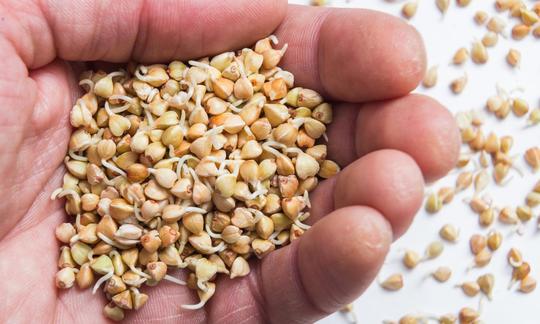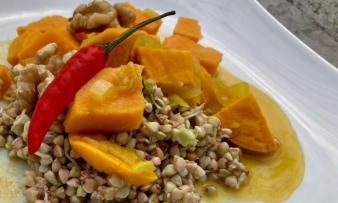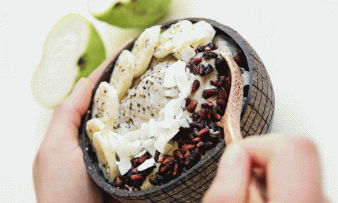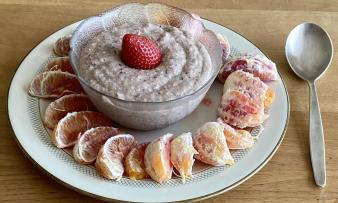Table of contents
Sprouted buckwheat ( Fagopyrum esculentum) has many uses. This gluten-free pseudocereal is suitable for sweet and savory dishes.
Use in the kitchen:
Fresh buckwheat sprouts can be eaten raw or sprinkled over salads, soups, stews or vegetable dishes. However, purchased sprouts are often pasteurized and therefore not raw food. This may be noted, but it does not have to be. Unfortunately, many manufacturers are not familiar with raw food and can, for example, use the term raw even though the product is pasteurized. That is why we show you in a recipe how to get buckwheat sprouts in raw food quality. Unfortunately, we have to answer the question "Is sprouted buckwheat pasteurized?" with: Yes, probably most of the time. For the time between production, delivery and storage in the store, this is practically the only way it works, unless they are very dried.
When processed into patties, flatbreads, rolls or crunchies, the sprouted pseudo-grain has a slightly longer shelf life. Sprouted buckwheat is also good as a filling for zucchini, tomatoes, peppers or cabbage rolls. You can also often find sweet desserts or muesli with buckwheat sprouts. Why not try these raw food rolls:
Recipe for raw buckwheat rolls:
Ingredients: 150 g almond pomace (or finely ground almonds), 150 g buckwheat flour (preferably from sprouted buckwheat), 1 zucchini (peeled, diced), juice of half a lemon, 4 pitted dates, 3 tablespoons psyllium husks, 1 teaspoon salt, 1 pinchof pepper.
Puree the zucchini, dates and lemon juice in a powerful blender, put in a bowl and mix well with almonds, buckwheat flour, psyllium seeds and spices. Knead the mixture into a dough with a little water if necessary and form small rolls. Dry the bread in a dehydrator or in the oven for 1 hour at 50 °C and then for a further 4 hours at 42 °C. Since they should still contain some residual moisture, they can be stored in the refrigerator. If you dry the sliced rolls in the dehydrator for another 1-2 hours before eating them, they taste even better. For example, you can top them with avocado, buckwheat sprouts, tomatoes and cucumbers. 1
Recipe for fresh buckwheat tea:
Buckwheat tea can be made from both the herb and the seeds. Pour a teaspoon of buckwheat seeds or a tablespoon of buckwheat herb (Herba Fagopyri) into a cup of boiling water and then let the mixture simmer for 3 minutes. This way, most of the medicinally effective rutin (flavonoid) gets into the drink. After 10 minutes, pour the tea through a fine sieve. 4 Drink two to three cups of the tea daily as a cure for four to eight weeks.
| Not only vegans or vegetarians should read this: Vegans often eat unhealthily. Avoidable nutritional mistakes. |
Shopping - where to buy?
Buckwheat seeds for germinating yourself can be found in supermarket chains such as Coop, Migros, Spar, Rewe, Edeka. They are rarely available in supermarkets such as Denner, Volg, Aldi, Lidl or Hofer. Russian grocery stores also sell buckwheat. Most whole buckwheat seeds on the market are very gently peeled and therefore still capable of germinating. However, due to the chemical treatment of conventional buckwheat seeds, we recommend that you buy organically produced buckwheat. You can find this in health food stores, organic shops, organic supermarkets or on the Internet.
As mentioned above, purchased sprouts are often pasteurized and therefore no longer raw food.
You can also buy dried, germinated buckwheat: To do this, you germinate the buckwheat grains and then dry them gently at below 42 °C. You can then nibble on the germinated seeds as a vegan snack or use them to refine soups, salads or muesli. 2
Homemade preparation:
What is germinated buckwheat? Under ideal conditions of heat, light and moisture, the seeds swell. After the shell has burst, the germ (embryo) develops into a seedling. The seedling includes the cotyledons, roots and stems, which are often not yet recognizable as such. Sprouts are the above-ground parts of the seedling, i.e. stems and leaves.
Raw buckwheat seeds can be easily and quickly germinated. To prepare, you should clean the equipment and utensils for the germination process with boiling hot water. Then soak the whole buckwheat grains in a bowl of water at room temperature for a maximum of 1 hour. Please note: Buckwheat will no longer germinate if soaked for too long.
After soaking, empty the grains into a fine-mesh sieve and rinse the buckwheat well. The sticky and somewhat slimy substance that clings to the seeds is starch. You should rinse it off well. Pour off the water and let the buckwheat rest and drain at room temperature. In the evening, rinse the grains again well and leave them in the sieve overnight. On the second morning, you will already see small sprouts. Depending on your needs, you can let the grains germinate for another day (rinse 1-3 times). The buckwheat sprouts can be used fresh, dried in a dehydrator or stored in the refrigerator for a few days.
Found in the wild:
In Central Europe, wild buckwheat grows along paths, forest edges, rubble and weedy areas. The wild stands only last a few years and mostly come from cultivation or sowing. 3
Storage:
Freshly sprouted buckwheat does not last very long. It is best to store it freshly rinsed and well drained in a sprouting jar or screw-top jar in the refrigerator and use it within a few days. However, you should rinse the sprouted buckwheat once a day. The ideal storage temperature to prevent the growth of unfavorable bacteria on the sprouts is 5 °C. If possible, set the refrigerator to this temperature. Some refrigerators also have a zero-degree compartment for such foods. 4
There should be no excess water left in the container. Please note that mold can easily develop due to the moist environment. Very fine fibrous roots can sometimes be seen on sprouts in general and also on buckwheat sprouts. These should not be confused with fungal hyphae, they are part of the fungal system.
Dried, germinated buckwheat can be stored for several months in a cool place, sealed against light and air. The prerequisite is that it has a water content of less than 15%.
Ingredients - nutritional value - calories:
The energy content of buckwheat is similar to that of grains. With around 340 kcal/100g, buckwheat is very nutritious. 5 Most of the energy comes from carbohydrates and high-quality protein. Buckwheat contains very easily digestible protein. The eight essential amino acids are in a beneficial nutritional ratio to one another.
Sprouted buckwheat has slightly less starch and more water than ungerminated buckwheat. During germination, the bioavailability of certain nutrients increases, so that the body can dissolve and digest them better. More information on the breakdown of phytic acid during the germination process can be found at this link. In addition, numerous more complex nutrients and enzymes are formed during germination, which make the sprout much more valuable than the bare seeds.
Health aspects - effects:
The sprouted version of buckwheat is particularly healthy and is often referred to as a superfood. First and foremost, sprouted buckwheat is very alkaline and regular consumption helps to break down excess acids. The sprouting process allows proteins, carbohydrates, vitamins and minerals to be broken down even better.
According to a study by the University of Manitoba (Canada), regular consumption of buckwheat can lead to a reduction in blood sugar levels. This is not only beneficial for diabetics, because the substance chiro-inositol it contains supports the regulation of blood sugar levels and thus reduces the risk of heart, nerve and kidney diseases. 6
The pigment rutin, which is also contained in sprouted buckwheat, reduced oxidative damage to the blood vessel walls in a test with rats and also lowered blood pressure. 7 The lecithin contained in sprouted buckwheat also increases brain activity and is said to prevent feelings of anxiety, depression and mental exhaustion. 8
Buckwheat is gluten-free and therefore ideal as a diet food for people with celiac disease or gluten sensitivity or intolerance. Since contamination can always occur during harvesting, please look for the gluten-free symbol on licensed products.
Dangers - Intolerances - Side effects:
There are two significant dangers when it comes to germination: mold and disease-causing microorganisms. Both spread rapidly in warm, moist environments and when hygiene is poor. Make sure that your surroundings are clean and avoid contact with used towels, cleaning sponges or the sink, even with fruit and vegetables.
Make sure you wash your hands thoroughly and boil the equipment you use. The high temperatures in summer in particular provide ideal conditions for the development of mold and the proliferation of pathogens. The slime that forms when sprouts are grown provides an excellent habitat for fungi and bacteria. It is therefore necessary to regularly rinse the seeds with cold water. 4
In 2011, there was an EHEC epidemic in Germany and France with a severe form of hemolytic uremic syndrome (HUS). The trigger for this epidemic was probably bacteria-infected sprouts of fenugreek seeds from Egypt.
Pregnant women are generally advised to avoid raw sprouts or germs. Certain bacteria, known as listeria, prefer to colonize easily perishable foods. These can cause infections and have a negative effect on the unborn child in pregnant women.
Buckwheat disease (buckwheat rash, fagopyrism) can occur with above-average consumption of unpeeled buckwheat. Sensitive people react with photosensitization (sensitivity to light). An itchy skin rash or gastrointestinal complaints can occur. 9
Use as a medicinal plant:
The rutosides (rutin) contained in buckwheat seeds and the green parts of the plant are used medicinally for venous disorders (chronic venous insufficiency). 3,10 A tea preparation can be helpful for venous and vascular weakness and can be used as an accompanying treatment for arteriosclerosis and varicose veins. 11
Folk medicine - naturopathy:
In folk medicine, buckwheat is also used to stop bleeding, treat retinal bleeding, treat venous congestion and stimulate milk secretion in women who have recently given birth. 11
Occurrence - Origin:
Where does buckwheat come from? True buckwheat is considered an ancient crop. It originally comes from Central to East Asia. 3 Its genetic center is thought to be in the Amur region. In the Middle Ages, the Mongols probably brought buckwheat to Central Europe. Here it grows primarily in heathland areas, low mountain ranges and in the southern Alpine region (Carinthia, Styria). 12
Where is buckwheat grown in Germany? Buckwheat is grown in small quantities in the Lüneburg Heath, in Schleswig-Holstein, in Westphalia, on the Lower Rhine, in the Eifel, in the Hunsrück, in Upper Franconia and in some German Alpine valleys. 3
Growing in the garden or as a potted plant:
True buckwheat is a heat-loving plant and is damaged by cold even at low temperatures (less than +3 °C). It prefers loose, sandy soils that are low in alkaline and moderately acidic. 3 Unhulled buckwheat of organic quality is suitable as seed. Buckwheat needs a soil temperature of over 10 °C to germinate, which is why it can be sown in Central Europe from mid-May at the earliest. It should be noted that the cultivation period is around ten to twelve weeks. Sowing should therefore be done so that the fruit can be harvested before the first frost in autumn. Despite many flowers, buckwheat only produces around nine nuts per plant due to uncertain cross-pollination.
Cultivation - Harvest:
In Europe, due to buckwheat's sensitivity to cold, cultivation is only possible up to about 70° north latitude and at altitudes of up to 800 m. In commercial cultivation, the harvest takes place using a combine harvester between the end of August and the beginning of September. Due to its sensitivity to the weather, buckwheat yields fluctuate greatly. According to Wikipedia, average yields are around 10 to 25 dt/ha, which is significantly less than wheat at 35.3 dt/ha. In good locations (wine-growing climates), buckwheat is used as a second crop. When grown as a catch crop, the flowering shoots can be used as green fodder six to nine weeks after sowing. 3
For human consumption, the husk (husk, wood fiber layer) of the buckwheat is removed mechanically in special hulling mills. The slightly darker, red-brown husk is very hard and is almost inedible, even after cooking. Thanks to a particularly gentle hulling process, the whole grains are still capable of germinating, provided they have not been roasted or otherwise heated beforehand. Hulling results in a high loss of whole grains (50-60%) as the seeds break easily. This broken part is usually used for flour, flakes, semolina or for further processing into pasta, beer, etc.
Unpeeled seeds are needed for cultivation in agriculture.
Animal protection - species protection - animal welfare:
Buckwheat is considered a good bee forage plant and the honey yields are comparable to those possible with rapeseed or phacelia. Buckwheat nectar contains an average of 46% sucrose. Each flower produces an average of 0.1 mg of sugar in 24 hours. 3
Buckwheat fields, with their long flowering period, provide a welcome source of food for many other insects. The relatively late flowering period from June/July to August/September is not otherwise present in the agricultural landscape. 13
General information:
What is buckwheat? The general term buckwheat usually refers to true buckwheat or common buckwheat ( Fagopyrum esculentum). This comes from the buckwheat genus ( Fagopyrum) and belongs to the knotweed family (Polygonaceae). Buckwheat is a pseudocereal 2, because unlike the "true cereals" it is not a monocotyledonous plant, but a dicotyledonous plant. 14
Another type of buckwheat is Tatar or false buckwheat ( Fagopyrum tataricum). This can be used in a similar way to true buckwheat ( Fagopyrum esculentum). Its ingredients and effects are comparable to those of true buckwheat. The main flowering period of this endangered species (in Switzerland and parts of Austria) is from July to September. 11
Alternative names:
Common names for true buckwheat are common buckwheat and buckwheat. Less well-known names are heather grain, heather, heather porridge, heather barley, blend, blend, brein, bokert, black Welschkorn, black plent, black polenta, gricken (lit. grikiai), tater, Sarazenenkorn or Turkish wheat. 3.15
Other Latin names for Fagopyrum esculentum are Fagopyrum cereale, F. sagittatum, F. sarracenicum, F. vulgare, Phegopyrum esculentum, Polygonum cereale and P. fagopyrum.
The medical name for buckwheat herb is Fagopyri herba syn. Herba Fagopyri. Buckwheat herb that contains the leaves and flowers of the plant harvested and dried during flowering is called Fagopyrum esculentum herb. 16
In colloquial English, sprouted buckwheat is referred to as "sprouted buckwheat", while in scientific texts the term "germinated" is common.
Literature - Sources:
Bibliography - 15 Sources
| 1. | Deine-ernährung.de Gekeimter Buchweizen - meine neueste Entdeckung. |
| 2. | Alnatura.de Gekeimter Buchweizen. |
| 3. | Wikipedia Echter Buchweizen. |
| 4. | Sprossen-keimlinge.de |
| 5. | USDA United States Departement of Agriculture. |
| 6. | American Chemical Society. Buckwheat May Be Beneficial For Managing Diabetes. ScienceDaily. 2003. |
| 7. | Kim DW, Hwang IK, Lim SS et al. Germinated Buckwheat extract decreases blood pressure and nitrotyrosine immunoreactivity in aortic endothelial cells in spontaneously hypertensitive rats. Phytother Res. 2009; 23(7). |
| 8. | Zentrum-der-Gesundheit.de Buchweizen - die gesunde Alternative. |
| 9. | Wikipedia Buchweizenkrankheit. |
| 10. | Pharmawiki.ch Rutosid (Rutin). |
| 11. | Fleischhauer SG, Guthmann J, Spiegelberger R. Enzyklopädie. Essbare Wildpflanzen. 2000 Pflanzen Mitteleuropas. 1. Auflage. Aarau: AT Verlag. 2013. |
| 12. | Tfz.bayern.de Technologie- und Förderzentrum TFZ Bayern. Anbauhinweise Buchweizen. |
| 13. | Biofarm.ch Buchweizen – der summend schöne Ewigblüher. |
| 14. | Wikipedia Amarant. |
| 16. | Awl.ch Heilpflanzenlexikon. Echter Buchweizen – Fagopyrum esculentum. |








Comments